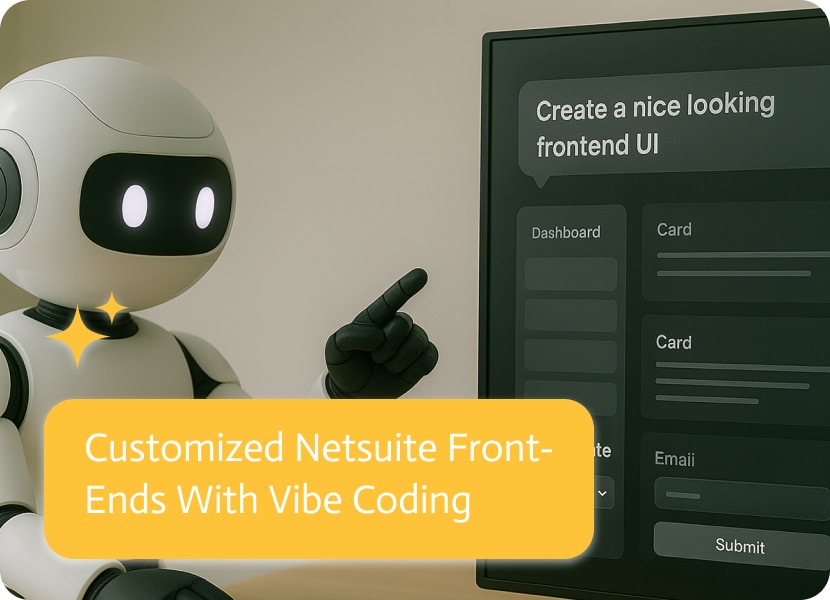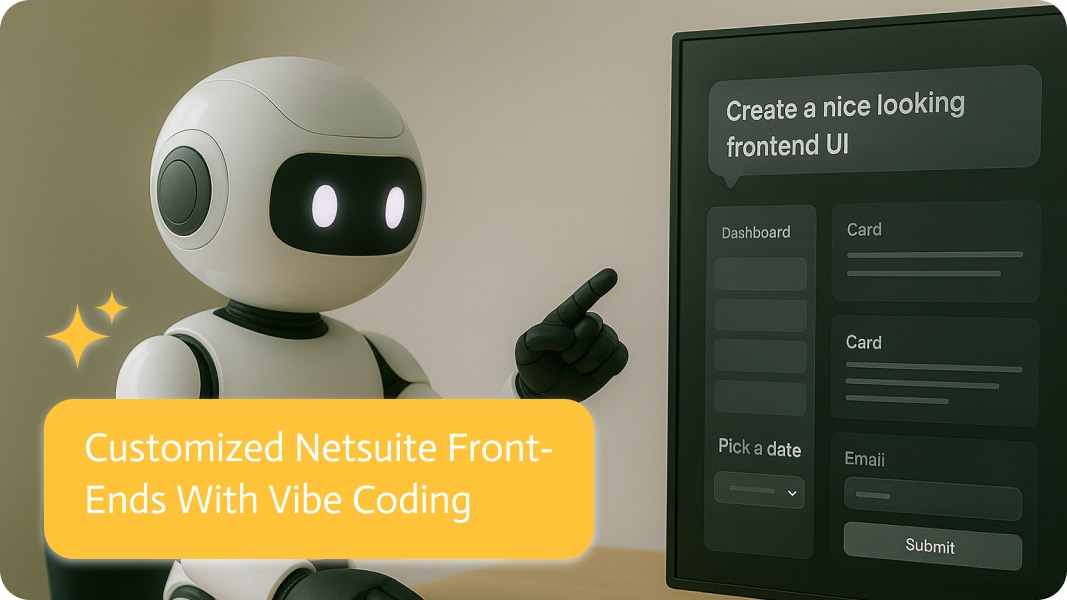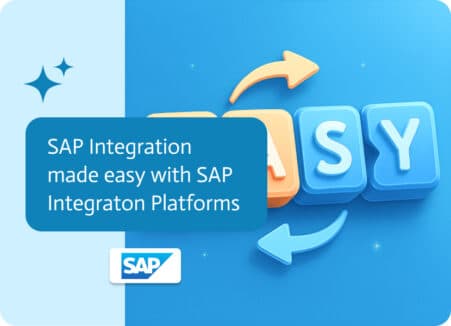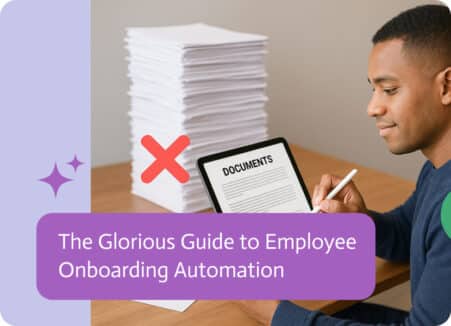

Vibe Coding Customized NetSuite Front-Ends
For more than two decades, NetSuite has been the reliable engine powering the operations of mid-market firms and sprawling enterprises alike. Its robust back-end has powered finance teams, managed supply chains, and helped sales leaders keep the gears of business turning. Yet despite this, NetSuite, and enterprise software in general, has long faced an unavoidable problem: while the database is brilliant, the user interaction is often clunky, rigid, and uninspiring.
This is where a new frontier of software development is emerging, and it’s being pushed forward by vibe coding. Building applications not by slogging through thousands of lines of JavaScript or meticulously wiring together APIs, but by telling AI what you want in plain English and letting it build it. Noca’s platform turns natural language into working applications that sit elegantly on top of native systems, including NetSuite.
The result is now anyone can design customized front-ends for NetSuite, tailored sales funnels, personalized dashboards, or role-specific mobile tools that reflect real workflows and update instantly. In essence, vibe coding allows NetSuite to shed its utilitarian skin and finally feel human.
ERP Friction and NetSuite Customization Challenges
ERPs like NetSuite, SAP, and Oracle often sacrifice ease of use for the sake of being all-encompassing. They are data-rich, but the experience of using them can often feel overly complicated when all you needed was a dashboard. A junior sales rep logging into NetSuite for the first time is probably going to encounter a maze of tabs, drop-downs, and pages crammed with information irrelevant to their day-to-day work.
That’s not a trivial inconvenience. Research from Gartner has repeatedly shown that complexity in enterprise software correlates directly with adoption problems. In one 2023 survey, 42 percent of workers admitted they avoided using their company’s ERP whenever they could, relying instead on spreadsheets or ad hoc communication. That gap between the system of record and the actual tools employees use creates inefficiency, compliance issues, and frustrates IT departments.
For executives, this complexity shows up in another way: decision-making bottlenecks. When dashboards are a bit rigid or difficult to interpret, managers lack visibility into important metrics at the right moment. Instead of seeing live performance updates, they’ll usually rely on stale quarterly reports or manually stitched-together presentations.
Vibe coding, applied to NetSuite, promises to dissolve much of that friction.
What Vibe Coding Delivers for NetSuite Users
At its core, vibe coding personalizes interfaces on a large scale. Using Noca, a sales manager could simply type: “Create a mobile-friendly dashboard showing each rep’s open opportunities, deal stage progression, and a live feed of new leads from marketing.” Within minutes, the platform would spin up a working front-end that pulls data from NetSuite, structures it according to the request, and delivers it in a clean, user-friendly design reachable on mobile or web.
The impact is not just on dashboards. Companies can create sales funnels that mirror real-world buyer behavior. Instead of a generic approach or a one-size-fits-all pipeline, vibe coding lets teams experiment with funnels tailored to industries, deal sizes, or customer profiles. A SaaS company, for example, could build a funnel that prioritizes product demo scheduling early in the process for enterprise buyers but emphasizes self-service onboarding for smaller clients.
The same principle applies to reporting. Finance officers might want an executive view highlighting revenue recognition, cash flow, and expense anomalies, while operations managers prefer granular reports on fulfillment or inventory churn. Traditional ERP customization would take weeks of developer effort; with Noca, it’s a matter of describing the output you want and refining it iteratively.
Why Mobile-Friendly NetSuite Front-Ends Matter
The shift to mobile work makes custom interfaces even more important. According to IDC, more than 60 percent of enterprise software interactions now happen on mobile devices or tablets. Yet ERP interfaces are notoriously bad at adapting to those dreaded tiny screens.
Here’s where vibe coding again fills the gap. Noca can automatically build mobile-friendly designs that show only important KPIs for each role. A field sales rep might open their phone to see today’s appointments, the status of pending contracts, and a one-click way to log meeting notes. A CFO, meanwhile, might get a simplified glance at cash reserves, expense approvals, and risk alerts.
The beauty of vibe coding is that these aren’t separate apps bolted onto NetSuite. They’re generated interfaces powered by NetSuite as the main data source. Data stays consistent, but the experience feels as streamlined as a consumer app.
From Customization Pain to Conversational NetSuite Design
Traditionally, tailoring NetSuite required hiring expensive consultants, waiting months for customization projects, and often ending up with unreliable workflows that broke after the very next software update. The rise of low-code platforms promised relief, but even those demanded a fair bit of technical fluency to get the most out of them.
Vibe coding changes the design method from detailed configuration to simple communication. Instead of dragging and dropping widgets in a builder, a PM just describes the experience they need: “a funnel that automatically triggers a customer success task when churn risk exceeds 20 percent,” and let Noca handle the details.
That shift has economic consequences. According to Forrester, enterprises spend billions each year on customizing their ERP. If vibe coding can reduce that reliance on consultants and internal development teams, the ROI could be enormous. More importantly, it frees companies to adapt faster; if a dashboard isn’t working, leaders don’t need to open a ticket and wait six weeks; they can re-describe the requirement and regenerate the view instantly.
Cultural Shifts in How Employees Use Software
Besides efficiency, there’s a people aspect to consider. Employees are used to easy digital experiences, like using social media or ordering a ride. When enterprise software feels outdated, it affects morale.
A 2024 Salesforce study showed 74 percent of workers under 35 said the usability of enterprise tools influenced their decision on whether they stuck with a company or not. In that light, customized NetSuite front ends aren’t based solely on productivity; they’re about keeping talent and employee satisfaction.
Noca’s approach fits this cultural moment. By letting workers describe the tools they want in plain language, it democratizes the design of software. IT no longer has to be the bottleneck; frontline employees can co-create the apps they actually need.
Risks and Questions Still Loom
Of course, this vision isn’t without caveats. Relying on artificial intelligence to build front ends is still being debated, especially with regard to security, governance, and the consistency of information. What happens if a poorly described request generates a funnel that misrepresents compliance data? How do IT teams audit the logic behind automatically generated dashboards?
Vendors like Noca are dealing with these worries by building safeguards. You can generate new front ends, but data access is still governed by existing NetSuite permissions. Similarly, AI-generated workflows can be reviewed and locked down by administrators before going live.
There’s also the question of long-term maintenance. IT leaders are careful of unofficial apps that appear if not monitored properly. If vibe coding produces dozens of role-specific dashboards and funnels, who maintains them over time? Advocates argue that because the system can regenerate experiences on demand, maintenance is less of a concern.
The Bigger Picture of Humanized NetSuite Front-Ends
The promise of vibe coding with Noca is not simply faster customization; it represents a philosophical shift in how enterprises think about their core systems. For decades, ERP platforms have been designed primarily for data integrity, comprehensiveness, and compliance. Usability was an afterthought.
Now, usability is the differentiator. In a marketplace where nearly every ERP can handle invoicing, forecasting, and procurement, the question becomes: How does it feel to use? Companies that offer employees consumer-grade experiences for enterprise tasks give themselves a slight edge, both in productivity and in pulling in new talent.
NetSuite, with its deep penetration in mid-sized businesses, is a prime beneficiary. By pairing its rock-solid back-end with AI-generated front-ends, companies can have the best of both worlds: reliability without rigidity.
What’s Next for Customized NetSuite Front-Ends
Vibe coding for NetSuite is still developing, but it’s gaining momentum. Analysts predict that by 2027, more than half of ERP users will use AI-generated interfaces instead of traditional dashboards. Noca is positioning themselves as the creators of this layer between people and enterprise systems.
If the trend continues, the enterprise app landscape could look radically different in just a few years. Instead of monolithic dashboards, we may see hundreds of micro-frontends built for specific situations and individuals. ERP systems will remain the backbone, but the face they present to workers will be infinitely more flexible and, crucially, designed with humans in mind.
Final Thoughts
NetSuite has always been about scale and integration. But in today’s workplace, scale isn’t enough. People want tools that fit their workflow, not the other way around. Vibe coding, powered by the likes of Noca, is emerging as the bridge between the brute strength of ERP systems and the user-friendliness of modern systems.
If successful, it will mark a significant change: enterprise software that feels as natural to use as the apps on our phones while still providing the rigor that businesses need. In that sense, vibe coding isn’t just a new way to customize NetSuite, it’s changing how we relate to these systems that run our companies.


